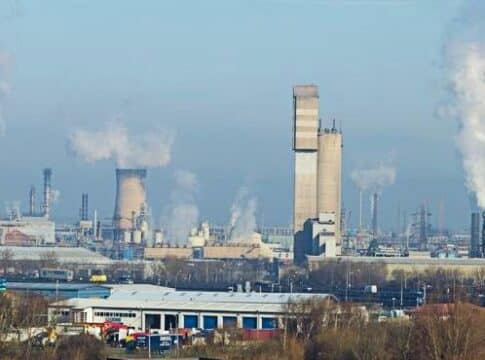UK Carbon Credit Scheme, ETS, Under Fire for Profitable Plant Closures
A loophole in the UK Emissions Trading System (ETS), designed to reduce planet-warming emissions, allows companies to profit millions of dollars from unused carbon credits after closing factories, leading to concerns about the misuse of the government scheme.
Notably, the closure of a fertilizer plant by US firm CF Industries in Cheshire resulted in a windfall of £32 million (over US$39M) from the sale of carbon credits. Several other companies, including Mitsubishi Chemical and Cemex, have also benefited from the said “loophole”, triggering calls for immediate regulatory changes.
The Controversy Surrounding UK ETS
Under the UK government carbon trading scheme, firms in the heavy industry are given a free allocation of emissions. This is to prevent UK businesses from being disadvantaged compared to their foreign peers operating in nations with weak climate policies.
Same as the EU ETS, companies in the UK must buy credits if their carbon emissions surpass their allocation. If they have unused or excess credits, they can sell those in carbon markets at the end of the year. The scheme is considered as fundamental to the UK’s net zero strategy.
Greenpeace’s Unearthed investigated the UK ETS. Their investigation found that the scheme allocated free carbon credits to companies that closed plants, thereby reducing their emissions.
There’s no time limit as to when the companies can sell the credits. That means they can wait when carbon prices are high to sell the credits and earn profits from it. The price surged to £100/tonne last year.
Unearthed particularly discovered that US fertilizer giant CF Industries received 630,000 carbon credits from shutting down two UK factories. The company first closed its plant in Ince last year, causing 350 job losses.
The unused carbon credits gave CF Industries an income of £32 million by selling those credits under the UK ETS. The total worth of the credits stand at £49M, using the average UK carbon price from 2022 of £78/tonne.
Another company, Mitsubishi Chemical, has also shut down one of its plants in Billingham, Teesside this 2023. This caused over 200 people to lose their jobs.
Production at one of the world’s biggest chemical plants stopped, causing a significant drop in the company’s emissions. The chemical plant emitted 182,000 tonnes of carbon in 2021, which dropped to only 6,000 in 2022 due to the closure. This leaves Mitsubishi with 155,000 free carbon allowances, which is worth about £12 million.
The investigation also found that the UK Government has no way to recall the credits once they have been allocated.
The issue has raised concerns among environmental campaigners about the prioritization of financial gains over environmental and social responsibilities.
RELATED: Inside Carbon Markets: Problems, Causes, and Potential Solutions
Calls for Regulatory Changes
With the growing outcry, policymakers called for an urgent solution to close the loophole in the UK carbon scheme. This loophole gives companies that reduce emissions by closing plants the opportunity to earn millions from trading carbon credits.
Labour MP Alex Cunningham, in particular, emphasized the need to prevent companies from capitalizing on emissions reductions at the expense of local jobs and communities.
The questionable practice has sparked debates about the effectiveness of market-based mechanisms in curbing emissions.
According to a carbon market expert at Carbon Market Watch, under the current UK ETS rules, a factory that shuts down on January 2nd will get free emissions allowances for the entire year. The government can’t get those credits back in any way.
Remarking on this scheme, the expert further noted that allocating carbon credits to ghost plants “doesn’t serve climate goals or any economic purpose.”
As per Unearthed, the UK government is currently reviewing its free carbon allowance rules. However, any proposed changes to the rules will be accommodated by 2026.
Whenever a firm stops operations or leaves the country, their carbon allowances won’t be distributed in the next year.
For the proponents of the carbon trading scheme, they argued that it helps the country in meeting its ambitious climate goals. It was able to cut emissions by over 48% since 1990, quicker than any other G7 nation.
A spokesman for the Department for Energy Security and Net Zero commented that:
“As previously announced, we are reviewing free allocation rules to make the system as robust as it can be while continuing to support UK businesses through the transition to net zero.”
In theory, carbon credit markets are designed to incentivize initiatives that reduce harmful emissions. Each credit represents a tonne of removed or avoided emissions.
While there are some issues surrounding the validity and quality of the credits in carbon markets, studies have shown that they helped major companies cut emissions. High quality credits meet a set of criteria, validating their emission reduction claims.
READ MORE: How Do Carbon Credits Reduce Emissions?
The UK’s emissions trading system has come under scrutiny as companies profit from the closure of factories and the resulting unused carbon credits. The controversy has led to demands for immediate regulatory amendments to prevent the misuse of the government carbon credit scheme meant to help achieve net zero emissions.
The post UK Carbon Credit Scheme, ETS, Under Fire for Profitable Plant Closures appeared first on Carbon Credits.



